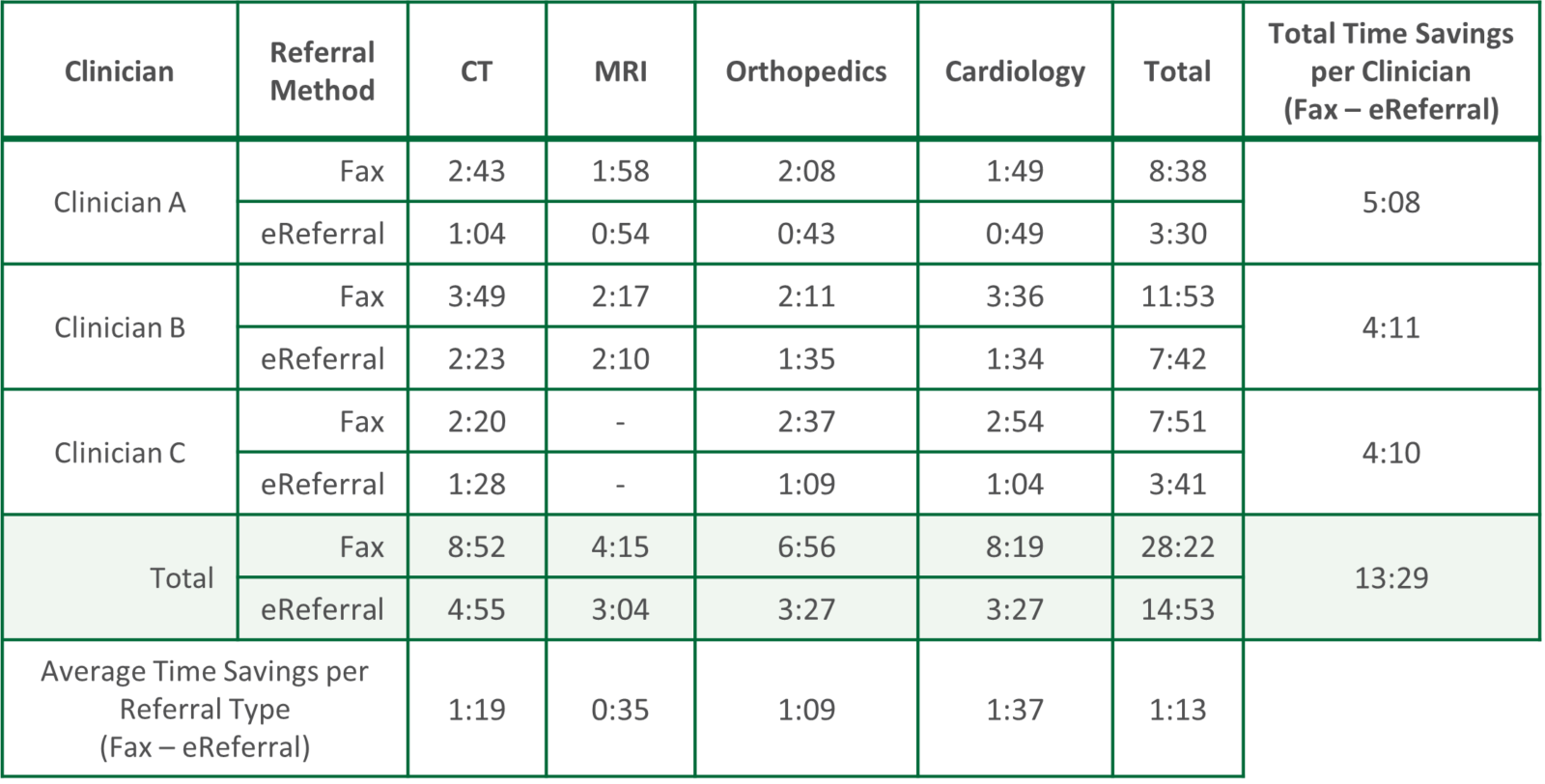Primary Care clinicians sending referrals, a time-based comparison of fax and eReferral workflows
Clinician burnout is a significant issue and can result in a number of negative consequences including suboptimal patient care delivery, adverse mental health outcomes, and an increased likelihood to leave the practice.1 According to the 2024 National Survey of Canadian Physicians, 44% of respondents reported feeling burned out to some extent, with 5% feeling completely burned out.2 One source of clinician burnout is increased time spent on clerical and administrative tasks within electronic medical records (EMR).1 Ideally, clinicians would prefer to spend less of their time on administrative tasks so they can maintain a better work-life balance and increase capacity for clinical care.1 As there is significant risk to primary care practices, solutions or interventions are needed to ensure primary care clinicians can continue to deliver critical care to their patient populations while minimizing the risk of burnout.
eReferral could provide a way to decrease administrative burden by reducing the amount of manual documentation and tracking required to send a referral. In this case study, the team aimed to assess the impact that the eReferral solution can have on the time spent sending referrals. A small group of 3 participating primary care clinicians completed a study seeking to measure the time required to send referrals in their normal practice environment while simulating real-world processes, using both fax and eReferral workflows. Below is a workflow diagram of the participating primary care clinicians that compares a summary of a fax workflow to an eReferral workflow. Each clinician had slight variances in their workflows depending on their workflow preferences, however the process below is common for all participants (Figure 1).

There are a few observable differences between the two workflows (Figure 1) which may have an impact on the time spent sending referrals. Namely, the first step of finding an appropriate referral form for the faxed workflow is not needed to send an eReferral. Through the eReferral solution, referral forms are built into the directory listings of recipients via the Healthmap. As well, the final step of setting up referral tracking for a faxed referral is not needed to send an eReferral, due to built-in tracking from the eReferral solution with an integrated EMR. These key differences between the workflows may offer efficiencies and time savings for the sending clinician. The findings from this study, expanded on the following pages, are promising and show that eReferral could be a tool, that following proper implementation and adoption, could support clinicians in reducing the time spent on administrative tasks.
Key takeaways
Early findings indicate that primary care clinicians experienced in eReferral use can send referrals faster and more efficiently using the eReferral solution when compared to fax-based methods of sending referrals.
For this study, four different test patient scenarios were developed, that indicated the need to send a referral to a specialist or health service including CT, MRI, Orthopedics, and Cardiology with the main goal of mirroring real-world scenarios as much as possible. Three primary care clinicians participated and completed the study requirements. The clinicians were asked to send referrals as they would in normal practice using their fax workflow first and then send the referral through the eReferral network to create comparable pairs of referral scenarios. One clinician could not produce a fax-based referral for the MRI, so this clinician only submitted 3 paired referral scenarios, where the other two completed four paired referral scenarios. The participating clinicians have been using eReferral for multiple years and are very comfortable with their workflows, all working within an integrated Telus PSS EMR. The results of the study are summarized below (Table 1).

Across the 11 paired referral scenarios, a total of 13 minutes and 29 seconds were saved when clinicians used eReferral to send referrals in comparison to using their fax-based workflows – an average of 1 minute and 13 seconds saved per case. In every case, the eReferral solution was quicker and saved the clinicians’ time.
The clinicians who participated in this case study estimated they send an average of 22 assess some possible time saving. Utilizing this number as an average for clinicians more broadly, we could assess some possible time savings:
If clinicians were using fax to send on average 22 fax referrals a week and if all these referrals were all completed using eReferral, that would mean that clinicians could save upwards of 26 minutes per week based on the findings from this study
Discussion
The findings in this case study, despite the limited sample size, highlight that utilizing the eReferral solution could reduce the number of minutes clinicians spend sending referrals on a daily and weekly basis, as well as increasing efficiency in their administrative tasks. Based on the quantitative timing analysis of the different steps within the clinicians’ workflows, one contributor to the additional time for the fax workflows was the need to build in the referral tracking elements manually following sending the referrals. In the fax workflows, the clinicians would go back into the patient file and add reminders to the file for future follow up to ensure that the referral was received, processed, and booked by the receiving site. In the eReferral workflows, the clinicians did not need to manually do this as the eReferral integration builds this in without any additional work effort. The integrated tracking not only saves time in the moment for the clinician sending the referral but also has time saving potential for clinical staff, like administration staff, who are looking for updates on the referral. A further time saving element not considered in this case study is the ability to send receivers direct messages via the eReferral platform. Without the eReferral platform, senders may be required to call the receivers office to relay a messages and vice versa; increased phone calling may result in decreased time spent on direct patient care, or increased work during “off-hours.” A participating clinician highlights the benefit of this feature:
eReferrals make communication between the referring clinician and the referral source much easier. They can add comments or requests which are easier to reply to, and we can further requests (for example, to triage a diagnostic imaging request more urgently based on new clinical symptoms) or add documents requested by them, all directly through the eReferral tool in the chart. This is not only more useful but saves a considerable amount of time for both the clinician and the referral source by not having to spend time on the phone trying to reach each other.
Participating Family Physician
The possible time savings may increase capacity for clinicians to allocate more time to direct patient care. One participating clinician noted the following regarding the time saving potential and benefits of the eReferral platform in clinical spaces:
I have been using digital health supports, like eReferral, for many years now. Every minute that can be saved on administrative tasks allows me to have extra time to spend with my patients, providing direct patient care. eReferral specifically allows me to avoid doing long searches to find out where to refer my patient or spending time figuring out if a specific referral form is a required and often allows me to see an approximate wait time for an appointment. Additional, tracking messages are automatically sent to the reception team to ensure that the referral doesn’t fall through the cracks and there are direct links in the chart for the team to check the referral status and add additional information as needed. eReferral is an invaluable tool in my practice.
Participating Nurse Practitioner
Overall, this study provided foundational insight into the impacts that eReferral could have on the referral sending workflow and highlighted some of the benefits that experienced eReferral users are seeing in their everyday practice. It highlights the potential that eReferral has in supporting clinicians in automating elements of their workflow to reduce the amount of time spent on administrative tasks with hopes that this can in time, reduce the risk of burnout and improve work-life balance.
Limitations & Future Opportunities
This study had several limitations which need to be considered when interpreting the results. This study was completed on a small scale and has a limited sample size; this reduces the variety of workflows that can be analyzed. Also, due to limited time, the clinicians were only able to complete one comparison pairing for each service/specialty. In addition, the participating clinicians had significant experience with eReferral and were early adopters of the solution which will increase the speed at which they are able to use the eReferral solution. This study was also completed in a test scenario which is a more controlled environment than what may be experienced in real-world practice scenarios. Additionally, all three clinicians worked within the same integrated EMR, Telus PSS. Other EMRs have different levels of integration that can affect the workflows for both sending and tracking referrals. Lastly, this study may not be representative of all clinician’s weekly referral volume. Referral volume may differ greatly per week due the need to send referrals during “off-hours” including evenings and weekends. Additionally, in this study, only four referral pathways were examined, additional referral pathways may have different forms which may impact time spent sending the referral.
Future study opportunities on this topic could include studying the amount of time required for managing previously sent referrals to learn more about the impacts that automatic tracking can have. It was noted by multiple clinicians that some of the most significant time savings that eReferral offers happen after the referral is sent due to the automatic updates and the direct messaging feature between referrers and receivers. Because of this, it reduces time searching or calling for this information if a patient requires an update on the status of their referral. Additionally, exploring the receiver’s workflow and better understanding the process of receiving referrals in both fax and eReferral workflows would provide further insights into eReferral efficiency across the continuum of care. Furthermore, expanding the scope of the study to include more clinicians with more variety in workflow, regionality, practice scope, and EMR systems would support making more wide-reaching claims to the impacts that eReferral can have on sending referral efficiency.
Acknowledgements
The Ontario eServices Program delivers digital services (eConsult and eReferral are the first initiatives in the scope of the program) that support clinical workflows and facilitate smoother transitions in care and an improved patient experience. The Ontario eServices Program is co-led by the Ontario eConsult Centre of Excellence (eConsult COE) and the eHealth Centre of Excellence (eCE) and is funded by Ontario Health.
1Peccoralo, L. A., Kaplan, C. A., Pietrzak, R. H., Charney, D. S., & Ripp, J. A. (2021). The impact of time spent on the electronic health record after work and of clerical work on burnout among clinical faculty. Journal of the American Medical Informatics Association : JAMIA, 28(5), 938–947. https://doi.org/10.1093/jamia/ocaa349
2Canada Health Infoway (2024). Infoway Insights: 2024 National Survey of Canadian Physicians. https://insights.infoway-inforoute.ca/2024-national-physician-survey.
Interested in learning more?
Interested in partnering with us or learning more about
what we can offer you? Please reach out here.
Get the latest resources and insights
-

Why eReferral is the Obvious Choice: Modernizing Healthcare Communication
eReferral is improving both the clinician and patient experience. This overview highlights the benefits of…
-

A case study on the implementation of a centralized, integrated Online Appointment Booking solution at a COVID-19, Cold & Flu Care Clinic
In 2021/2022, Ontario Health (OH) funded the implementation of a centralized, integrated Online Appointment Booking…
-

A case study on the impact of the heart failure EMR tool in primary care
Heart failure is a chronic condition with a high risk of death. Once diagnosed with…
-

Cutting the after-hours: How AI scribes are giving clinicians their time back
Sharing some learnings from an AI scribes evaluation in Ontario that shows how these new…